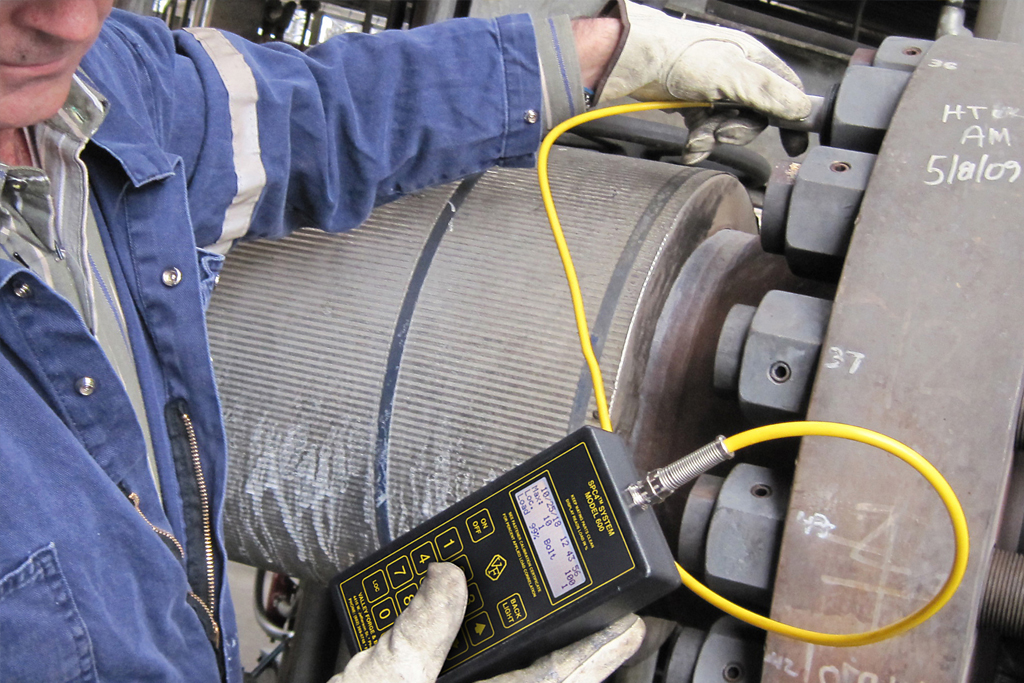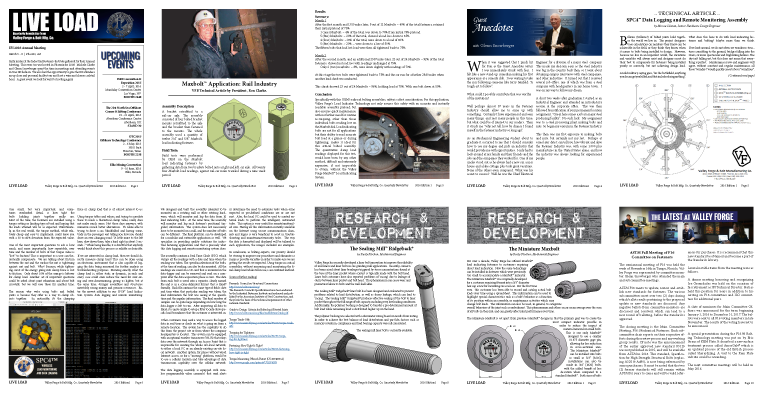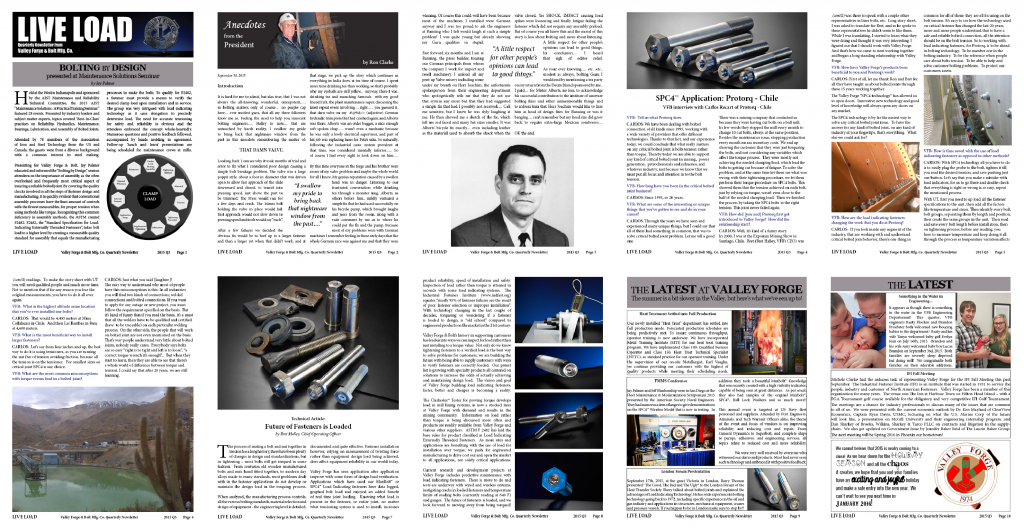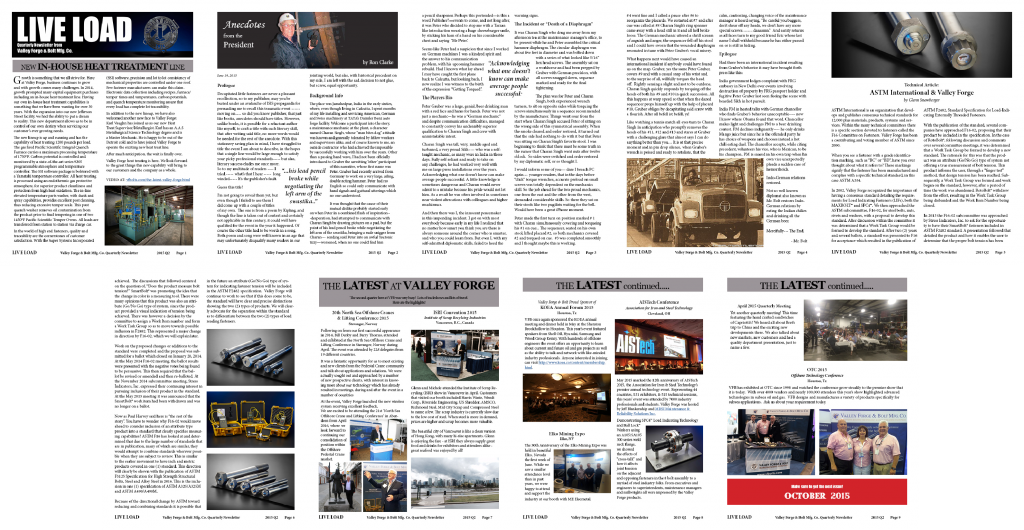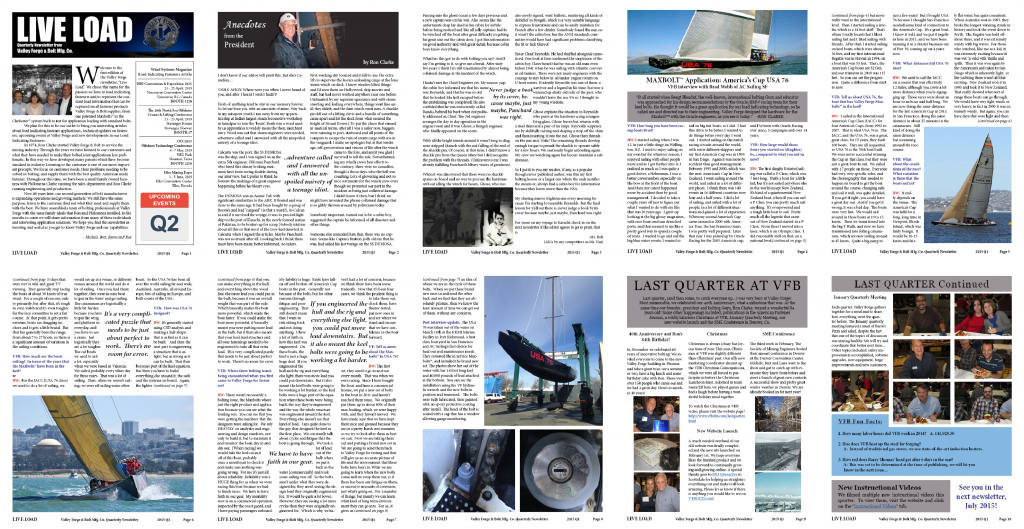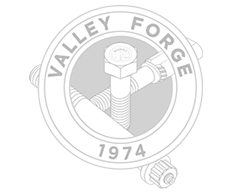The Latest At Valley Forge
Load-indicating fastener technology senses grinding mill clamp load in real time
A large polymetallic underground mine in South Australia is using technology to improve safety and productivity. Because the mine is one of the largest global suppliers of the metals being mined, every aspect of the operation was put under the microscope—from the vehicles moving material to the kinds of bolts used in its autogenous grinding mills. Valley Forge & Bolt, a Phoenix-based maker of custom fasteners, used its unique Load Indicating Technology to assist the mine in this focus on efficiency.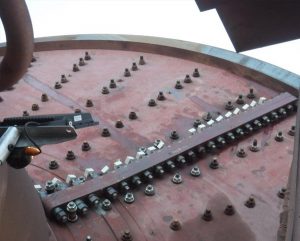
Valley Forge’s SPC4™ bolts have built-in load indicators that measure clamp load in real time and relay the information to a variety of meter options. When accompanying wireless probes are linked to the SPC4 bolts, mine engineers are able to incorporate the captured data into their SCADA system and track changes to clamp load as it happens, in situ.
“There was a feeling that this particular mill was nearing the end of its service life,” said Brandon Proebster, sales engineer for Valley Forge & Bolt. “Mine engineers wanted the ability to closely monitor its performance to strike that balance between getting maximum use out of the equipment, but not pushing it beyond its service life.”
Valley Forge’s bolts with Load Indicating Technology, such as SPC4, are accurate to within +/-5%, measuring full bolt stress from zero to 100% rather than a single load preset like some other fasteners that purport to indicate load.
Proebster and Valley Forge’s regional director, Barry Thomas, traveled to the mine to get a better understanding of conditions on the ground and what mine engineers hoped to accomplish. The mills begin their process with material the size of footballs that is then processed down to powder. It is in this violent transformation that vibration within the mill takes its toll on bolted joints.
To reduce expensive manual monitoring of the joints and to prolong the life of the equipment, Valley Forge custom manufactured a total of 376 SPC4 bolts, ranging in size from 2.5 to 3.5 inches in diameter and from 10 to 16 inches in length. The installation also included electronic and mechanical load meters. A set of SPC4-702 wireless sensors was then added, allowing the SPC4 bolts to deliver real-time data to the site’s mill monitoring dashboard.
“Engineers selected strategic locations for the SPC4 fasteners within the mill, focusing attention on areas deemed to be most critical,” said Proebster. “Using SPC4, we replaced the radial flange and trunnion bolts at both the feed and discharge ends.”
Due to the severe service conditions present in large grinding mill applications, the fasteners used to assemble the mill shell are considered “critical fasteners” and require regular testing and maintenance. Traditionally, ultrasonic elongation testing is used to ensure that proper clamp load is being maintained. However, this method requires a scheduled outage and trained personnel to accurately interpret the results. Ultrasonic measurement also fails to provide real-time bolt load information.
With the SPC4’s ability to tie into the mine’s SCADA system, engineers got their first-ever real-time look at how the mill’s performance affects clamp load. Doing so without requiring a planned outage saved precious time and money, a benefit that continues. Plus, the information gleaned informs maintenance schedules and provides early alerts to potential problems. The data also provides insight into the general health of equipment.
In the ensuing months, mine engineers transitioned other grinding mill shell fasteners to SPC4. “Alerting operators to the smallest loss of tension in real time allows them to immediately investigate, diagnose, and prevent equipment failure,” said Proebster. “The information provided by SPC4 bolts is extremely valuable because time is money.”
More so, according to mine personnel, the use of Valley Forge & Bolt’s wireless data-relaying load indicating fasteners was a huge gain for mine safety and asset integrity.

Load-indicating fasteners measure tension directly, and not just at installation
Critical joints require controlled bolting throughout their service life to maintain performance, enhance safety, save time, and improve uptime. However, the term is more often applied to installation than to the service life of the bolted joint. Valley Forge & Bolt’s family of load-indicating fasteners makes it possible to monitor bolted joints after installation and to always know fastener tension regardless of the service interval.
While there are no bolts that tighten themselves yet, the tension-based monitoring system of Valley Forge load-indicating fasteners is a reality, offering far greater accuracy than torque-based methods. Valley Forge & Bolt offers controlled bolting with technology that makes it possible to measure the tension directly from the bolt, not relying on inaccurate torque-based measurements. Accurate to within a staggering +/-5% of minimum yield of the fastener, and ASTM F2482 compliant, now bolted joints can tell you their exact percentage of load at any time.
This load-indicating fastener technology is available in Valley Forge products Maxbolt™ Load Indicating Fasteners and the SPC4™ Load Indicating System. Each fastener tells you its percentage of minimum yield on a 0 to 100 scale using either a built-in meter (Maxbolt) or, in the case of bolts with SPC4 technology, using quick-connect meters or wireless sensors to provide a precise measure of the load.
Catastrophic joint failure is costly and dangerous, underscoring the need for accurate, consistent, and repeatable controlled bolting. Yet measuring torque to determine tension is inaccurate, indirect, and inadequate.
With Maxbolt and SPC4, any technician at any experience level can achieve accurate, consistent, and repeatable bolting, not only at installation, but also throughout service life. At maintenance intervals, they will know the accurate tension in seconds and only need to tighten those fasteners that require it. Wireless-compatible SPC4 can even be integrated into a plant’s condition monitoring system for remote readings and in-use monitoring.
The result is an unbeatable joint-fastening solution that assures accurate tensioning for the service life of a fastener, increases speed of installation and maintenance, and saves labor costs—all while increasing safety and improving performance.
Learn more about the complete lineup of Valley Forge & Bolt load-indicating fasteners here.
About Valley Forge & Bolt
Valley Forge & Bolt Mfg. Co. proudly produces innovative, industry-leading fasteners. From start to finish, no matter the bolting issue or the industry, the company’s expertise and resources provide endless capabilities and immeasurable combined bolting experience. Their patented bolting products are widely trusted for their unrivaled quality, extraordinary performance, and enduring reliability. With the ability to produce both standard and custom fasteners to customer drawings and specifications, Valley Forge & Bolt is truly a custom bolt manufacturer, and has been doing it proudly for 45 years. Valley Forge & Bolt Mfg. Co., 4410 W. Jefferson Street, Phoenix, AZ 85043. Call: 1 (800) 832-6587.
Proprietary technology interprets clamp load within bolts, provides remote monitoring capability
Knowing the tension of critical joints is a matter of safety, peak performance, and maximum uptime. Valley Forge & Bolt is shifting the paradigm with SPC4™ Load-Indicating Technology that makes it possible to measure the actual tension in a fastener, not just the preload that is being applied by torque or tension tools. By using SPC4™ and any one of its specially designed interchangeable readers, technicians can quickly and easily gauge tension and even have the option of remotely monitoring fastener tension within SPC4™ bolted joints.
Around the globe, SPC4™ solves complex bolting issues in mining, oil and gas, refining, nuclear, power generation, rail, crane, steel mill, military, and subsea industries.
SPC4™ is proprietary technology from Valley Forge that is ASTM F2482 compliant and accurately measures direct tension in the fastener within +/- 5%. It provides absolute, real-time knowledge of fastener tension and performance—from installation through fastener life.
SPC4™ measures the stretch of the bolt (in other words, the bolt tension), directly from the fastener. Because stretch is the force that creates clamp load, this capability makes SPC4™ the most accurate method available to monitor the clamp load of critical joints.
With SPC4™, virtually any technician can use any type of tightening tool—hydraulic, pneumatic, electric, or a hand wrench—and still achieve even and optimal load on a bolted joint. SPC4™ can measure preload in the fastener at installation, monitor load while in service, or measure load and load loss during maintenance inspections. The result is optimal joint integrity, less downtime, and safe performance of equipment.
Valley Forge engineers and manufactures a variety of SPC4™ readers in analog and electronic formats to suit any application and any budget. Technicians simply quick-connect the reader to a datum disc on the end of the SPC4™ fastener, and the tension is displayed in real time on the reader as a percentage of minimal yield strength. Any reader can be used with any SPC4™ fastener. Electronic readers, offered in both wired and wireless configurations, provide digital and Bluetooth output, installation tool control, and load data recording systems. Wireless readers allows for real-time remote load monitoring and include Wi-Fi and low frequency options.
SPC4™ technology is available in standard bolts, studs, custom designs, and retrofits for customer-supplied fasteners, each modified with Valley Forge’s exclusive datum disc and gauge pin compatible with any Valley Forge-supplied reader. Save time and money, improve safety and performance, and increase the speed and repeatability of accurate installation of bolted joints. Learn more here.
About Valley Forge & Bolt
Valley Forge & Bolt Mfg. Co. proudly produces innovative, industry-leading fasteners. From start to finish, no matter the bolting issue or the industry, the company’s expertise and resources provide endless capabilities and immeasurable combined bolting experience. Their patented bolting products are widely trusted for their unrivaled quality, extraordinary performance, and enduring reliability. With the ability to produce both standard and custom fasteners to customer drawings and specifications, Valley Forge & Bolt is truly a custom bolt manufacturer, and has been doing it proudly for 45 years. Valley Forge & Bolt Mfg. Co., 4410 W. Jefferson Street, Phoenix, AZ 85043. Call: 1 (800) 832-6587. 1 (602) 269-5748.

Built-in load monitoring device helps reduce downtime, premature wear, and catastrophic joint failures
Bolts and fasteners might be small, but their failure can cause big problems. In some critical industries—including processing, mining, and energy—joint failure is considered a major safety issue and keeping up with replacements is expensive. Work shutdowns required for change-out can cost several thousand dollars at a time, and add up to millions over the course of a year. Some businesses have gotten used to replacing more than a dozen broken bolts each day! It doesn’t have to be this way.
Maxbolt™ Load Indicating Fasteners, a patented product of Valley Forge & Bolt Mfg. Co., can revolutionize how a company looks at fasteners—and reduce downtime, premature wear, and catastrophic joint failures. How can a simple bolt be so effective? For starters, Maxbolt is far from simple. There is an extremely accurate and durable load-monitoring device inserted into each fastener. At a glance, technicians will know when proper load is achieved. During operation, technicians will know if load ever falls out of spec on any bolt, addressing the need immediately instead of waiting for critical equipment failure.
Now, even inexperienced operators can assemble complex bolted joints with uniform clamp loads within +/-5% of design specification. With Maxbolts, measurements are based on tension, the inaccuracies of torque control are eliminated, ensuring optimum initial conditions before an assembly is placed into service.
Once in service, Maxbolts provide monitoring to warn users of initial relaxation and any subsequent loosening during operation, with just a quick glance required to confirm clamp load status. Custom Maxbolt labels can show desired operating ranges using a green zone or pinpoint precise clamp load values. The Maxbolt Load Indicating System provides the ultimate safety and reliability in a bolted joint, acting as a constant barometer of the integrity of the bolted joint and providing an added degree of safety.
Any industry that experiences loss of clamp load in fasteners can benefit from Maxbolt. Success stories have been documented in industries as diverse as mining, steel mills, oil and gas, rail, petro/chem, and nuclear. One Valley Forge & Bolt customer estimates they’ve saved $20 million per year, simply by switching to Maxbolt!
There are only two technologies for industry to choose in order to meet ASTM F-2482, the standard for load-indicating externally threaded fasteners, while maintaining values to within +/-5% accuracy, Maxbolt and a second technology, SPC4™. Unlike Maxbolt™, for which a reader is integral to the bolt, fasteners with SPC4 allow technicians to verify load by attaching a probe to a datum disc usually located on the head of the fastener and reading the load value. Valley Forge & Bolt manufactures both the Maxbolt and SPC4.
Learn more about Maxbolt here.
About Valley Forge & Bolt
Valley Forge & Bolt Mfg. Co. proudly produces innovative, industry-leading fasteners. From start to finish, no matter the bolting issue or the industry, the company’s expertise and resources provide endless capabilities and immeasurable combined bolting experience. Their patented bolting products are widely trusted for their unrivaled quality, extraordinary performance, and enduring reliability. With the ability to produce both standard and custom fasteners to customer drawings and specifications, Valley Forge & Bolt is truly a custom bolt manufacturer, and has been doing it proudly for 45 years.Valley Forge & Bolt Mfg. Co., 4410 W. Jefferson Street, Phoenix, AZ 85043. Call: 1 (800) 832-6587.
Valley Forge & Bolt’s load indicating fastener could help the wind industry lower its O&M costs.
By Kenneth Carter
As printed in Wind Systems Magazine June 2017
Since 1974, Valley Forge & Bolt has supplied bolts and fasteners for a variety of industries that include mining, oil and gas, cranes, scrap metal, and cement processing.
With a recent addition to its line of products, Valley Forge & Bolt is making inroads into wind.
“We have a product which is perfect for the wind industry,” said CEO Michele Clarke.
That product is called a load indicating fastener, and its installation in wind turbines could greatly reduce maintenance, according to Clarke.
“Usually, when you have a fastener, you have a specification to torque it. Load has been translated into torque but it is uncertain what load is actually on the fastener,” she said. A load indicating fastener will show you direct load on the fastener regardless of how much torque you apply. You’re actually seeing the design load on the fastener.”
 Load Indicating Fastener Specifications
Load Indicating Fastener Specifications
Valley Forge & Bolt follows the ASTM F-2482 specification when it comes to Load Indicating Fasteners. That specification allows the company to be within plus-or-minus 5 percent accuracy on a fastener’s designed load, per the ASTM standard. Fasteners using torque have been found to have a direct load accuracy tolerance of plus-or-minus 30 percent, some refer to the torque to tension relationship.
With this technology, an end user can quickly see if a fastener is losing load. This becomes very important in critical applications.
In a recent application for the oil and gas industry, Valley Forge was able to replace standard conventional studs of a 20-year-old heat exchanger with its load indicating fasteners. The exchanger was infamous for being a notorious leaker. By replacing the studs, the company was able to save about $213,000 over the course of five years.
Translating the load indicating fastener into the wind industry also could reap economic benefits, according to Clarke.
“That’s how we’ve excelled in this industry,” Clarke said. “We’ve been providing an added feature of seeing load on your fastener.”
Collecting Data
With more and more wind farms seeking out ways to translate the constant flow of data coming from wind assets into useful information that can prevent maintenance and save on the bottom line, Valley Forge & Bolts has developed a new type of fastener that will help collect that data, according to Clarke.
“What we have for wind is a wireless transmission probe that, using Wi-Fi, will send your load information to your tower data collection points,” she said.
Being able to pull data from the fasteners can prevent or delay costly maintenance visits, according to Clarke.
“Instead of a man having to go up the tower with torque wrenches on his back, you can just poll the tower, and you can say, OK, bolt number 22 is a little bit low, but we can wait until we next go up for maintenance,” she said.
Preventing Maintenance
But Clarke said if load indicating fasteners are installed at the beginning of an asset’s installation, then bolt maintenance issues are reduced.
Problems arise from the use of unnecessary torque, and when the fasteners are unevenly loaded, that’s how they can end up breaking.
“Some fasteners are carrying more load than the other fasteners,” Clarke said. “And those fasteners get too much load and then they crack and you have all these problems.”
So the advantages for the wind industry are twofold.
“I think for the wind industry, if we could get in there and get perfect installation, then they’d just recheck,” she said. “With our system, the fastener can send data once a day or it can send data once a week. And then you’ll just have a router that collects the data and downloads it, and nobody has to climb up that tower and tighten fastener unless it is warranted.”
A large part of the advantage of Valley Forge’s Wi-Fi fasteners will be their ability to keep maintenance costs down as well as keeping wind technicians from potentially hazardous conditions when possible, according to Clarke.
Clarke also sees Valley Forge’s fastener technology being extremely helpful in offshore wind.
“On those projects, they put a man down by helicopter to tighten the fasteners,” she said. “I can imagine this would save a fortune if you don’t have to put somebody out there unless the bolts are really coming loose or having issues.”
The fasteners’ ability to transmit data on their status makes it a perfect application when it comes to tech safety, according to Clarke.
Colorado Project
Clarke said Valley Forge is involved with a wind project in Colorado with a German company.
“It’s a project that we’ve supplied some load indicating fasteners, not the wireless,” she said.
The project has been moved back over the past few months mainly because of wind complications, but Clarke said the project should be ready to install by June.
“This one will be our first big installation for a big OEM,” she said.
Clarke said Valley Forge also manufactures a washer for the foundation bolts that could be helpful when building turbines.
“The foundations on these towers are critical, and we’re testing that one out,” she said. “That’s another product we would offer up to the wind industry.”
In the meantime, Clarke said Valley Forge plans to focus on what it does well. About 40 percent of the company’s business is with the mining industry, and it’s there where the wireless fasteners are going to be rigorously tested.
“We have three mining installations in South America running with wireless, and we’re going to have one in Australia in July,” she said. “That’s going to be a big installation. They’re basically doing a large quantity of wireless probes on a rotating ore crushing mill.”
Started with Mines
Clarke’s father, Ron Clarke, started Valley Forge 43 years ago.
“He had experience in making and designing and setting up these large forging machines all over the world,” Clarke said. “He started making bolts for mines here in Arizona. Slowly, we’ve developed what I think makes us unique, a large volume of patented products that we’ve developed.”
By being involved in so many industries, Clarke said it has given Valley Forge the ability to adapt and offer products and services that best serve its customer’s needs.
“Basically, we’ve spent these years developing solutions that solve customer’s problems by going to their sites and seeing what’s working and what’s not working in their bolting applications, then we come up with ideas that have made their maintenance and safety issues easier to handle which saves them downtime. Saving downtime always translates directly into saving money” she said.
Reprint courtesy of Wind Systems Magazine June 2017
To download the full PDF version of one of our VF Newsletters: Live Load, click on the photo below.
2016: Edition I (click to read)
IFI Annual Meeting
Maxbolt Application: Rail Industry
Guest Anecdotes with Glenn Snowberger
Technical Article:SPC4 Data Logging, Remote Monitoring
R&D: The Mini Maxbolt and The Sealing Mill Liner Bolt
click image to download complete pdf
![]()

